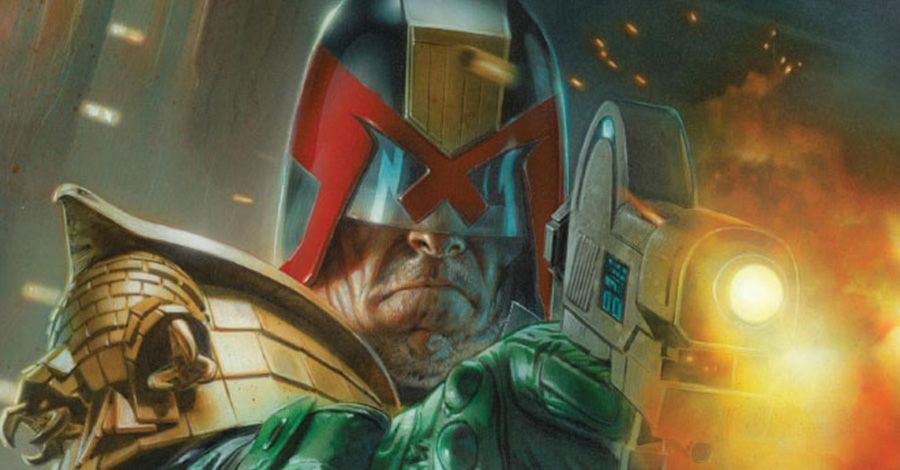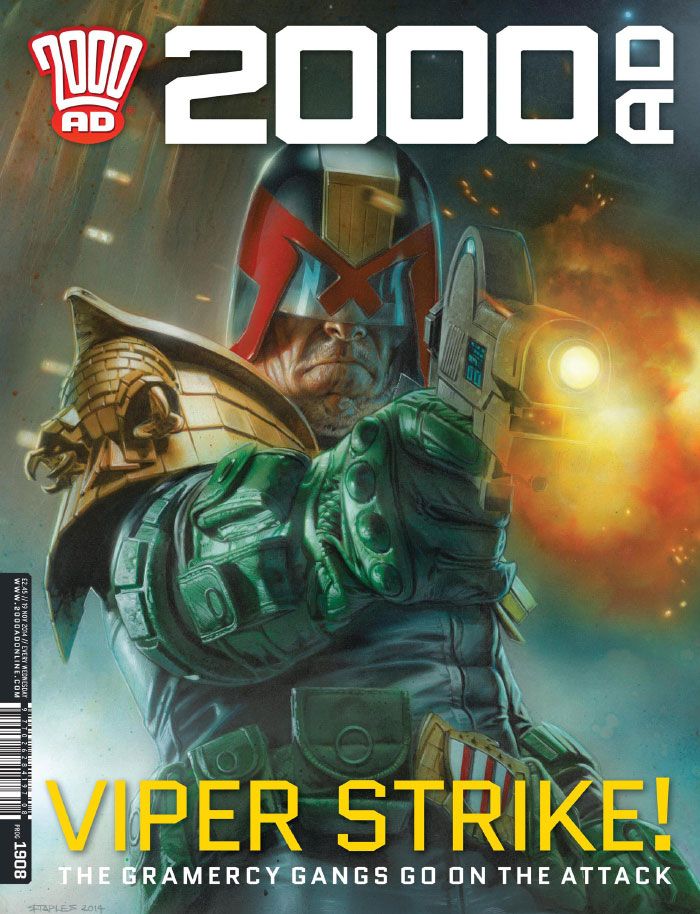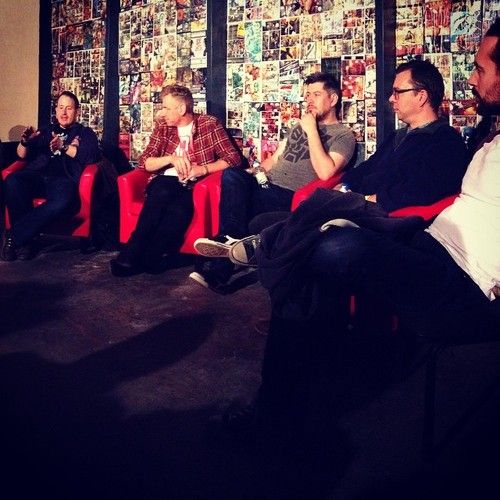Hosted by Stacey Whittle and Iz McAuliffe, a huge group of Tharg's finest gathered in Thought Bubble's 'Speech Bubble' area to talk about their work in "2000 AD" and Judge Dredd Megazine. In a packed, standing room-only discussion, writers and artists alike joined up to discuss breaking in to the company, working in comics - and the very best way to kill off Judge Dredd.
In attendance were Tom Eglington ("Outlier"), Simon Davis ("Slaine"), Boo Cook ("Damnation Station"), Alec Worley ("Dandridge"), Chris Weston ("Indigo Prime"), Ben Willsher ("Judge Dredd"), Henry Flint ("Zombo") and Jon Davis-Hunt ("Age of the Wolf") -- a collection of writers and artists who have covered just about every part of the World of "2000 AD." "2000 AD" PR guru Mike Molcher was also in attendance, and his infrequent heckles were firmly shut down by Whittle.
The panel started off with a rundown of how each member of the panel first found out about "2000 AD," and which was their first issue. Eglington said that he got into it through his brother -- specifically his brother's collection of "Robo-Hunter" by John Wagner and Ian Gibson. The most alluring thing about the issue, to begin with, was that it came with a pack of Griddles on the front. Davis was on holiday in Wales when he picked up a copy up at the newsagent. Although he tailed off on issues, he came back eventually.
Worley said that he was banned from getting issues by his mother -- something echoed by Flint, who said that his mother bought him his first issue when he was seven, and off sick from school. He got to read the very first two issues of the Prog until his mother decided to have a look inside issue #3 and see what her son was actually reading. From that moment on, he was never allowed to read "2000 AD" again!
Davis-Hunt said that he's first been brought in by some of the covers featuring "ABC Warriors", and was hooked into the comic with Grant Morrison and Steve Yeowell's "Zenith" series. Weston was also attracted to a cover: the infamous cover to Prog #3 where a man yells, "Shoot me, boss! Don't let it eat me alive!" whilst trapped in the jaws of a dinosaur.
The panel also mentioned their first work at "2000 AD" as professionals, and as expected, most of the panel said their first strip was a "Future Shock": four-page stories with a twist at the end, typically created by new creators to "2000 AD," as their pitch for future work at the publisher. Cook started with one called "Home from The War" with Steve Moore, whilst Eglington got to work on a story drawn by one of his heroes, Steve Yeowell.
However, Willsher said his first was on "Sinister Dexter," a series he got to work on after a series of previous rejections. His tenacity paid off eventually, although he said that he wished he could redraw all his art from the story.
Weston joked that he got into "2000 AD" as a result of the British Comics Invasion, which saw a huge group of British comics talent head to the states. With a vacuum created, he stepped into the breach and went straight into "Judge Dredd." He also worked on "Strontium Dog," which turned out to be the first work for Flint at "2000 AD." Laughing, they said that they'd hoped to be the Bolland and McMahon of the series.
Asked about their creative process, Davis said that he still preferred to work on board, with no computers. It's perhaps old-fashioned, but he prefers the method of painting out the artwork. He said that he'd been lucky to get to work on long runs with people like Pat Mills and Dan Abnett, who had both been happy to write in fun things for him to draw. He was interrupted to ask if he meant "moustaches" when he said "fun things," and told the audience that he was "the go-to guy for 'staches."
Cook liked to change his style often, to keep things fresh. He used to work mostly digitally, but then twigged that he couldn't sell digital pages! Since then, he's moved back to paper, although he does the coloring in Photoshop. Eglington said that when he writes he uses notebooks, brainstorming ideas, followed by pitches, then scripts. He finds that dialogue tends to come first, then he adds in panel descriptions, but tries to leave space for the artists to play around. In terms of adapting style for different artists, he brought up Cook as an example. When they work together, he changes his writing style to let the artist have more freedom in what he gets to draw.
Worley said that he's a bit of a "process nerd" and likes to breakdown his pitch, and then his chapters, and then the script. He tends to ask lots of questions about the tone of the writing, before breaking things down into three acts. Scripting, once he's got past that step (the most difficult, he said), becomes far easier at that point. He used to sketch out panels, but then decided against doing it, calling it "the worst thing a writer can do." He reads a lot of writing guides -- he mentioned the recent one by Brian Michael Bendis, as well as Scott McCloud's work -- and keeps a 300-page document about "what not to do."
Weston uses photorealism as part of his process, and begins by arranging a photo shoot: dragging in friends and family to help stage out the scenes. This helps him work on things like lighting, and small elements like the way clothes fall on a character. He then draws across the photos to make them look like other people, rather than his friends! Davis-Hunt also uses photos for reference in much the same way, but also collects together photos that fit a certain mood, which matches the story he's working on. These mood boards help him get under the skin of a story. He tends to work at a really intense scale -- at around 200 times the size of the page.
Willsher says that the first thing he does with a script is read it, very, very carefully. He then reads through it a page at a time, it sounds, drawing little stick figures on each page to demonstrate who is talking to whom, and how many people should be in each panel. Then he heads to a computer to lay out his pages based on the script. With Photoshop, he can alter the size of each panel, stretch them around to improve the panel flow. He then uses this as a guide for his work, which he does on paper.
In terms of advice -- both the best advice they'd been given and what they would offer to aspiring creators -- Davis-Hunt was told to think of pages as a whole composition. The layouts have to play into the whole. He recommended 'moving the camera' as often as possible, to keep things moving. He also told people not to give in at first. Making it in comics is as much about tenacity as it is about talent, a sentiment echoed by the other panelists.
Flint was advised to never draw a square panel. The only other panels that can then be used are also square, which restricts the page layout options. He said that when he first started in comics, he did work for a lot of publishers, but "2000 AD" was always his dream job. His advice was, "When working towards your dream job, make sure that you aren't so focused on the destination that you don't enjoy the comics you're currently working on."
Willsher said if there is any particular thing aspiring artists hate drawing, they need to draw it over and over again -- draw it until it becomes second nature. He also reminded artists that they need to always consider the letterer, and leave space for where word balloons could be used. Weston remembered being told the concept of having all the characters face into the centre of each page, which draws the reader into the story. He thought this seemed strange at first, but found that it really helped him with composition. He also reminded artists to tailor their portfolio to who would be seeing it -- editors want to see sequential work, not posters and pin-ups.
The panel also suggested talking around and reading as many guides as possible. One about Jack Kirby was cited in particular, as Kirby's ability to guide the reader through each page was hailed as some of the best work ever done in comics. In talking about some of the writing guides and books he read and learnt from, Worley also mentioned a personal blog post he recently wrote about breaking in at "2000 AD".
Eglington said that people should think of comics as being comics, rather than a film storyboard. It's a singular way to tell stories, and works in different ways to any other medium. Weston agreed, and said that writers should remember that comics are a static medium. A single panel can't have more than one action in it. For example, he cited the idea of a panel description being, "He draws a gun, and shoots it" -- which isn't a single panel of action, it's at least two. One of the other artists added that they'd once been asked to draw "flickering lights" in a single panel, to laughter from the audience.
During the audience Q&A session, attendees asked about a myriad of topics, including the concept of a shared "2000 AD" Universe in film. Willsher said that he'd be the first to champion it, as "2000 AD" have a wealth of characters who could show up. There are already shared universes within the comic itself, however, like the Pat Mills Universe, where readers can always get their fix.
As the panel came to a close, the panellists mused on the question, "If you could write the ending of any character, who would it be and how would they go out?" Weston mused on various ways he could kill off Sinister Dexter, settling eventually on some kind of fatal STD. The panel then jumped to the obvious answer -- Judge Dredd -- and tried to think of the best way to kill him off. Willsher wondered if the best ending would be that he gets killed by a random kid with a gun, his authoritarian, lethal methods finally catching up with him.
Worley, however, had the final answer. He said that halfway through a story, with no fanfare or build-up, he'd just have Dredd choke on an olive. Case closed.



